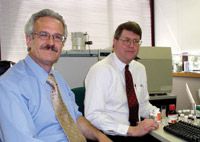Corporate Retrospective 2007: JEOL
I firmly believe that the most significant development in mass spectrometry in this decade - or perhaps even the history of mass spectrometry - will turn out to be the ability to measure samples directly in open air under ambient conditions. In my experience of using mass spectrometry for the past thirty-plus years, the biggest limitation has always been the need to insert samples into a high-vacuum chamber, or to dissolve the samples and inject them or deposit them onto a prepared surface. The ability to analyze samples immediately by using open-air analysis without these restrictions has been very liberating, and it has made it possible to analyze a much wider variety of materials. I no longer hesitate to try an analysis because I am not sure about extraction, solubility, volatility, likelihood of contaminating the mass spectrometer, or whether the sample will go through a GC or LC column.
I firmly believe that the most significant development in mass spectrometry in this decade - or perhaps even the history of mass spectrometry - will turn out to be the ability to measure samples directly in open air under ambient conditions. In my experience of using mass spectrometry for the past thirty-plus years, the biggest limitation has always been the need to insert samples into a high-vacuum chamber, or to dissolve the samples and inject them or deposit them onto a prepared surface. The ability to analyze samples immediately by using open-air analysis without these restrictions has been very liberating, and it has made it possible to analyze a much wider variety of materials. I no longer hesitate to try an analysis because I am not sure about extraction, solubility, volatility, likelihood of contaminating the mass spectrometer, or whether the sample will go through a GC or LC column.

The ability to generate a comprehensive mass spectrum of exact masses that represent the specific components in a sample gives you unique, pattern-specific mass spectra that can be used to identify unknowns or the chemical composition of virtually any substance. Open-air mass spectrometry is, according to a major government institution, "one of the greatest advances in technology in our fight against crime." Potential applications are nearly unlimited, and the ability to characterize mixtures or samples in their native state revolutionizes mass spectrometry.
For the past 25 years, LCGC North America has witnessed many improvements in separation science. Sample amounts for LC have been significantly reduced. GC analysis is much faster than ever before. And now direct analysis can be done without separations. LCGC has remained a constant forum for analytical chemists.
Mass spectrometry has become increasingly mainstream in the past fifteen years, and has undergone vast improvements with computer control and smaller components. The biggest risk of recent advances is that mass spectrometers will be treated as a "black box" detector. Education in the basics of mass spectrometry will allow scientists to examine the data critically and avoid mistakes.

Dr. Robert Cody and Dr. J. Douglas Meinhart
Dr. Robert Cody and Dr. J. Douglas Meinhart
JEOL USA, Inc.
Peabody, Massachusetts

Removing Double-Stranded RNA Impurities Using Chromatography
April 8th 2025Researchers from Agency for Science, Technology and Research in Singapore recently published a review article exploring how chromatography can be used to remove double-stranded RNA impurities during mRNA therapeutics production.
The Effect of Time and Tide On PFAS Concentrations in Estuaries
April 8th 2025Oliver Jones and Navneet Singh from RMIT University, Melbourne, Australia discuss a recent study they conducted to investigate the relationship between tidal cycles and PFAS concentrations in estuarine systems, and offer practical advice on the sample preparation and LC–MS/MS techniques they used to achieve the best results.



















